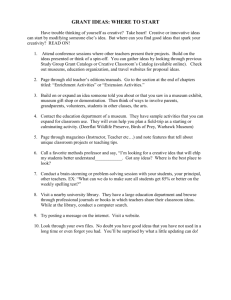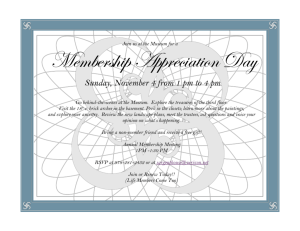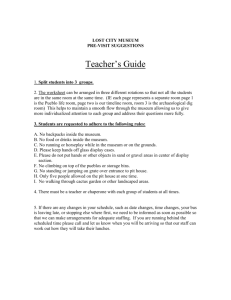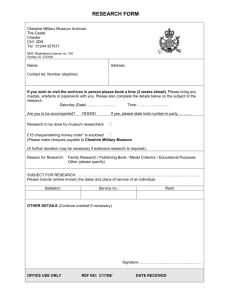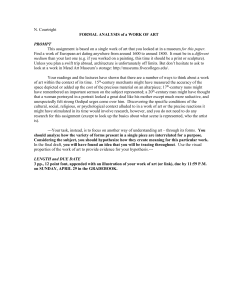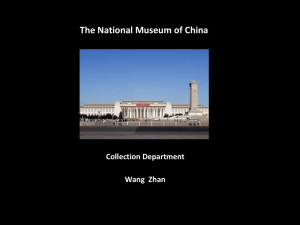city history museum
advertisement
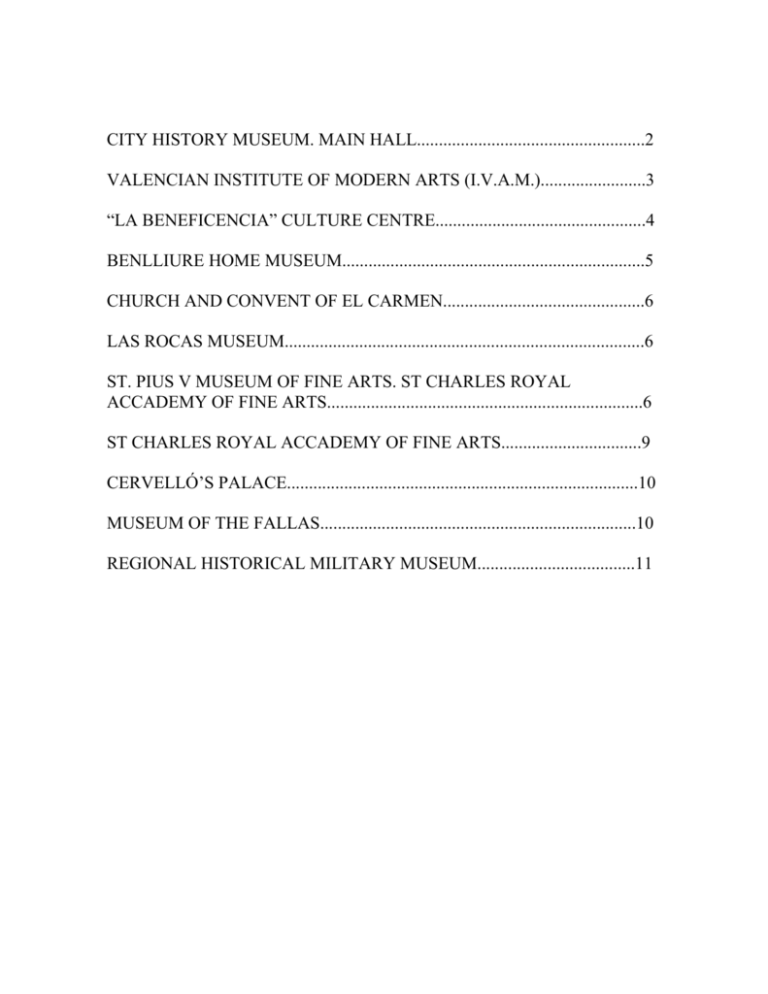
CITY HISTORY MUSEUM. MAIN HALL....................................................2 VALENCIAN INSTITUTE OF MODERN ARTS (I.V.A.M.)........................3 “LA BENEFICENCIA” CULTURE CENTRE................................................4 BENLLIURE HOME MUSEUM.....................................................................5 CHURCH AND CONVENT OF EL CARMEN..............................................6 LAS ROCAS MUSEUM..................................................................................6 ST. PIUS V MUSEUM OF FINE ARTS. ST CHARLES ROYAL ACCADEMY OF FINE ARTS........................................................................6 ST CHARLES ROYAL ACCADEMY OF FINE ARTS................................9 CERVELLÓ’S PALACE................................................................................10 MUSEUM OF THE FALLAS........................................................................10 REGIONAL HISTORICAL MILITARY MUSEUM....................................11 CITY HISTORY MUSEUM. MAIN HALL www.ayto-valencia.es Shortly, this space will home the History Museum of Valencia, a museum for all publics and with manifold levels of communication with the visitors. A very original exhibition proposal that combines the traditional resources with scenographic recreations and technological solutions of the latest generation. CONTENTS: THE ORCHARD AREA AT THE ROMANS ARRIVAL VALENTIA, A ROMAN CITY VALENTIA, A VISIGOTHIC CITY. AN EPISCOPAL CITY BALANSIYA: LAND AND WATER. THE MOSLEM CITY RECONQUERED VALENCIA. CATALONIAN-ARAGONESE CONQUEST AND COLONIZATION VALENCIAN GOLDEN AGE. FROM THE ECONOMIC PROSPERITY PERIOD TO THE CRISIS OF THE GERMANIAS VALENCIA IN THE EMPIRE. THE VICEROYAL COURT 18th CENTURY. THE BOURBON PERIOD 19th CENTURY. FROM THE INQUISITION TO THE VAPOUR. AND THE INDUSTRIAL CITY th 20 CENTURY. FROM THE REPUBLIC TO THE DICTATORSHIP. THE DEMOCRACY VALENCIA TODAY AND TOMORROW. THE THIRD MILLENNIUM The contents will be complemented with 3 further narrative arguments such as: Transverse themes: aspects outside chronology, for example: domestic life conditions, ways of leisure, city management, currency, price of things, market, taxes, weights and measures, cults and worships, the orchard... Landmarks: Events, historic topics or artistic manifestations, festive or cultural, that have marked the history of Valencia through different historic periods: October the 9th, Murs i Valls factory, Taula de canvis, reginal exhibitions, the fallas... Historic celebrities: Among others: The Cid, James the First, Saint Vicent Ferrer, Francesc Eiximenis, Alfonso V, Lluis Vives, Joan Caro, Juan de Ribera, Vicent Tomás Tosca, Antoni Josep Cavanilles, Vicente Blasco Ibáñez... VALENCIAN INSTITUTE OF MODERN ARTS (I.V.A.M.) www.ivam.es At the IVAM, contemporary art always has a special place. Appart from the temporary programme guide, the Museum has three permanent exhibitions which the visitor can enjoy at any time. Julio González Julio González Centre - Gallery 2 (Julio González Hall) Julio González (Barcelona, 1876 – Paris, 1942) is one of the main sculptors of the 20th century. His work, not very prolific, is distributed among the best museums of modern art; his collections at the Musée National d´Art Moderne, Centre Georges Pompidou (París), Museo Nacional Centro de Arte Reina Sofía (Madrid) and Museum of Modern Art of New York are some of his best works. The most important collection from Julio González is the one at the IVAM, consisting of nearly 400 pieces (sculptures, drawings, paintings and craftsmanship in precious metals). The IVAM collection Julio González centre - Gallery 3 and gallery 4 A journey around the Permanent Collection of the Institut Valencià d´Art Modern can give us a wide panoramic view of what has been the development of the very varied artistic options that have characterized the 20th century. In view of the magnitude of the museum heritage, it is necessary to make a selection and a systematic presentation that updates, analyzes, shows and spreads with a rigurous approach the different aspects that make the Collection of the IVAM one of the best assorted collections of modern and contemporary art in the Spanish cultural context. Ignacio PINAZO Julio González centre – Gallery 5 (Pinazo Hall) The IVAM has the most important public collection of works from the Valencian painter Ignacio Pinazo Camarlench (Valencia, 1849 – Godella, 1916). It consists of one hundred paintings and more than six hundred drawings. Half of this exceptional whole was donated by the Pinazo family in 1986 to the Valencian Generalitat. This exhibition presents a selection of sixty-five paintings and fifty drawings, in thematic and chronological order, that illustrate the evolution of one of the influent artists from the transitional period between the 19 th and 20th centuries in Spain. The mature work of Ignacio Pinazo, extraordinarily represented in the collection of the IVAM, anticipated many of the landmarks that would later define the 20th century painting. “LA BENEFICENCIA” CULTURE CENTRE C/ Corona, 36 www.xarxamuseus.com Completely restored and refurbished, it is since 1995 a great culture complex that homes the Domingo Fletcher Museum of Prehistory and Valencian Cultures, the Ethnology Museum, the Parpalló Hall and the Valencian Institute of Studies and Investigation. Among the contents that can be permanently enjoyed at La Beneficencia Culture Centre, the Museum of Prehistory stands out for its quality and amount of referenced pieces. THE VALENCIAN ARCHAEOLOGY THE PREHISTORY I- The lower and medium Paleolithic: the first inhabitants IIIIIIVVVIVIIVIII- The upper Paleolithic: the great hunters. The Paleolithic art: animals and symbols. The Epipaleolithic: the last hunters. The Neolithic: the first farmers and stockbreeders The Postpaleolithic Art: images and believes. The Eneolithic: the metal age The Bronze age: the diversity of cultures. THE IBERIAN WORLD IThe mediterranean world IIThe Iberians: a culture and a mosaic of villages IIIThe great Iberian villages and its environment: economic aspects IVThe Iberian house VVIVII- The funeral and religious world of the Iberians The Tossal of Sant Miquel: the city of Edeta and its territory The Iberian writing THE ROMAN AGE NUMISMATIC STUDIO IThe Iberian Numismatics IINumismatics: Valencian discoveries of the 10th-19th centuries THE ISLAMIC VALENCIA Hall under preparation THE CHRISTIAN MEDIEVAL VALENCIA Hall under preparation VALENCIAN CULTURE, TRADITION AND ETHNOLOGY IThe agriculture IIThe domestic area IIIThe flok architecture IVThe forest and the mountain VThe festive cycle VIThe religious cycle VII- The life cycle VIII- The stockbreeding IXThe costume XThe furniture XIThe jobs XII- Transformed farming and animals XIII- The transport and the commerce CITIES AND CRAFTSMEN Hall under preparation INDUSTRIAL ARCHAEOLOGY Hall under preparation BENLLIURE HOME MUSEUM C/ Blanquerías, 23 www.ayto-valencia.es The Home-Museum that is located in Blanquerías Street, very close to the Serranos Towers, contains more than 150 works of Don José Benlliure Gil (Cañameral 1855-Valencia 1937) and another 200 of his son, Pepino Benlliure, who died in 1916, when he was only 30 years old, follower of his father and Sorolla. The museum has also works of Joaquín Sorolla, Muñoz Degraín, the Blas brothers, a select Library, collecting objects such as ceramics, fans or curious garments from his models and photograhs. CHURCH AND CONVENT OF EL CARMEN Plaza del Carmen, 7 – C/ Museo www.ivam.es The Carmen centre is a reference of the activity of numerous generations of artists, both local and national, and foreigners. It is a culture centre dependent on the IVAM and it is currently undergoing significant reforms. LAS ROCAS MUSEUM C/ de las Rocas, 3 – C/ Roteros, 10 www.ayto-valencia.es Its origin goes back to 1435 when its building was started to serve as a store for the “rocks”, monumental carriages, which since the 15th century parade in the popular procession of El Corpus. At the present time it homes objects used at the festivals, and keeps the “Rocas”, the three eagles and the frames of the giants. ST. PIUS V MUSEUM OF FINE ARTS. ST. CHARLES ROYAL ACADEMY OF FINE ARTS C/ San Pío V ST. PIUS V MUSEUM OF FINE ARTS www.cult.gva.es/mbav/ It is considered the second most important museum in Spain besides el Prado, classification that it has gaigned mostly due to the great collection of medieval gothic boards called “valencian primitives”, that have made it famous worldwide, for both its quality and the wide selection that it presents. GOTHIC PAINTING HALL The journey starts with the Scenes on the life of Saint Luke, attributed to the Maestro of Villahermosa, from the end of the 14 th century and which constitute the most ancient paintings in the Museum. At the beginning of the 15th century, the Valencian painting was comparable to the most beautiful and refined painting in Europe at that moment. The Retablo de la Santa Cruz, attributed to Miguel Alcanyís, was the masterpiece at the time. Between the 15th and 16th centuries, a series of painters with a defined personality that can be called “protorenacentista” coexisted in Valencia. The main one was Rodrigo de Osona with a board of the Piedad, whose genius would be followed by his son, Francisco de Osona. RENAISSANCE PAINTING HALL Another one of the emblematic contents of St Pius V Museum is found in the Hall destined to the Renaissance painting. The trip of Spanish artists to Italian lands, and the fact that they brought back the language of the Renaissance in the fifties with them, would have a remarkable impact in Valencia. Among the paintings that can be admired here, the Virgen de las Fiebres is the most outstanding one, by its unique beauty, being the only known work from Il Pinturicchio in Spain. The Museum contains also works from crucial artists for the 16th century Spanish painting, such as El Greco, whose irrefutable personal style is reflected in the San Juan Bautista. BAROQUE PAINTING HALL The 17th century, golden period for the Spanish painting, has in Valencia one of it most prolific schools. We can also admire in this museum works from Francisco Ribalta, who would initiate a particular defined school after moving to Valencia in 1599. One of his best naturalist examples is his San Francisco abrazado al crucificado. The prodigious reredos of the Cartuja de Portacoeli is also remarkable. And equally important is the painting from his son, Juan Ribalta. After Ribalta, the most important Valencian painter from the 17 th century is Jerónimo Jacinto de Espinosa. Another Valencian, universally known by his barroque painting is José Ribera. The Museum homes the splendid painting Martirio de San Sebastián atendido por Santa Irene y una esclava. The Museum homes as well a select collection of barroque paintings, with works from highly relevant painters, such as Pedro Orrente and bartolomé Esteban Murillo. The impressive Autorretrato de Diego Velásquez, the most emblematic painting in the museum, stands out from this collection. THE ACADEMIC PAINTING In Valencia, the 18th century did not bring a rupture with previous tradition, but a continuation; the Saint Charles Royal Academy of Fine Arts, created in 1768, would be the one to determine the change of preferences on the local arts, with more inclination to the classicism of a baroque origin, led by the most prominent characters in the academic circle, like José Vergara, Manuel Monfort, José Camarón, Vicente Marzo, Vicente López or Mariano Salvador Maella. Towards the end of the century, as a nexus with the following, the academic painting was centered in two figures: the Valencian Vicente López and the Aragonese Francisco de Goya, two genius that would create in a same period two different ways of conceiving painting. From the first, we need to mention his compositions about the Virgin, such as the Virgen de la Misericordia and Virgen de la Merced Redentora; although the portraits are undoubtedly the works in which he shows all his pictorical quality, being a suitable example the great Retrato del General Ramón María de Narváez, Duque de Valencia, in which we can appreciate the great preciosity that he dedicates to detail. The other emblematic representant of Spanish and universal painting is Francisco de Goya, who was closely bound to Valencia through his relation with Saint Charles Academy. The Museum homes a good collection, mostly consisting of the portraits of characters close to the great painter, such as the Retrato de Doña Joaquina Candado, of a unique beauty, and the fabulous Retrato de San Francisco Bayeu. THE 19TH AND 20TH CENTURY PAINTING The 19th constitutes a prolific period for Valencian art, as it is full of great painters, thoroughly known around the plastic arts world from that time, which was considered as “the new golden age of Valencian painting”. All these artists studied at the Saint Charles Academy of Valencia, and they formed a coherent and well- defined school whose contribution to the spanish pictoric arts innovation would be determinant. This school consolidates on the works from four emblematic artists: Francisco Domingo Marqués, Ignacio Pinazo Camarlench, Jose Benlliure and Joaquin Sorolla Bastida. The Museum also contains a large collection of works from Antonio Muñoz Degraín, as well as a very representative collection from Valencian painters of the 20th century. SAINT CHARLES ROYAL ACADEMY OF FINE ARTS www.realacademiasancarlos.com The Saint Charles Royal Academy of Fine Arts is appointed by H.M. The King, associated to the Spanish Institute and of public nature. Its current role is as the Valencian Community Consultative Institute for culture matters, after Decree from 12th June 1989, and its Honorary President is the President of the Valencian Generalitat. The Academy, in its quality of owner of most of the paintings exhibited at the Saint Pius V Museum, is in charge of their maintenance and their correct social use. The Academy is integrated by professionals from the art world, and it is managed under its Internal Statutes and Regulations. It is divided into five sections: Architecture, Sculpture, Painting-Engraving, Music and Image Arts. Also, as a Culture Institution, it offers concerts, conferences, social gatherings, literature talks, etc. The Royal Academy has its originn in 1768, as the King Charles the Third decided to create a school where Architecture, Painting, Sculpture and Engraving were taught. There learnt the most famous students, that were to be artists of reknown prestige. It received importanbt donations of works from teachers and students from the start, as well as from the authorities and culture and political institutions. That is how it gradually enriched its patrimony, forming a little museum. With the passing of time and due to the large number of students and the consequent lack of sapace, the State transferred in 1838 the disentailed Convento del Carmen to the Academy, so that it could maintain its teaching character, and where it could highlight its art collections, grouped at the Museum of Fine Arts and the Antiques Museum. In 1909 the Saint Charles Royal Academy of Fine Arts was acknowledged to be an arts organism responding to three fundamental aspects or roles: Academic: art erudition studies, expert reports and dictaminations; Didactic: theoretic and practical teaching on Fine Arts; Educative: creation of the Painting and Sculpture Museum. But later on, the goverment was to separate art teaching from all the Academies, creating the Schools of Fine Arts , which function independently from the Academies, so, the rooms from the Convento del Carmen were wholy occuppied by the School of Fine Arts. Finally, the Saint Charles Royal Academy of Fine Arts and the Provincial Museum were moved to the former Saint Pius V Convent in 1942, where they currently share premises. CERVELLÓ PALACE 3, Plaza de Tetuán www.ayto-valencia.es Restored to be the headquarters of the City Archives, the Cervelló Palace is destined to home both a museum, a public centre and a research centre. The Museum will be divided into four parts: - History of the palace and the Cervelló’s family - The 19th century and the political history of the city - Characters from the 19th century, their most relevant biographical dates related to Valencia - Permanent Exhibition of the City Archive contents MUSEM OF THE FALLAS www.fallas.com This Museum, currently established in a building that used to be a convent of the Saint Paul’s Order, is dedicated to the Fallas. The creation of the fallas is a task of the fallero artists, and they are the result of the united efforts of the inhabitants from each quarter, who groupe in commissions and work the whole year long in order to organize the celebrations. Each fallero artist chooses the best figure from the monument he is creating, which is called from then on a ninot, and a few weeks before the placement of the fallas in the streets, all the selected ninots are presented in an exhibition. A popular vote decides which ninot is going to be rewarded being exempted from the fire, according to its beauty or its wit and satiric intention. The two ninots rewarded each year (one from the large fallas and another from the children fallas), are incorporated to this Museum. They contribute, along with pictures of the best fallas and advertising posters which have won previous annual competitions, to conform the Museum background and to enhance this major celebration, the Valencian Fallas, being patrimony of the popular culture. REGIONAL HISTORIC MILTARY MUSEUM The Regional Historic Militar Museum is a young museum that shows objects, weapons and testimonies related to the History of the Spanish Army, to divulge its traditions and epics, and bring it near to the society that it serves. The visit to this museum allows some to remember past times serving in the army, others to know relevant facts in the Spanish History, in which the participation of the army was crucial. It has two floors, halls and patios with a total of more than 1500 square meters of exhibitions. Armament, gun material, transmissions, knives, helmets, models, uniforms, miniatures, logistic equipments, hero’s galleries and different military objects are shown in this museum. The Research and Consult Library completes the marked didactic character of this Museum. The museum is orientated to everyone, above all to the schools and educational associations and groups which are interested in extending their knowledge of Spain and its Army.
